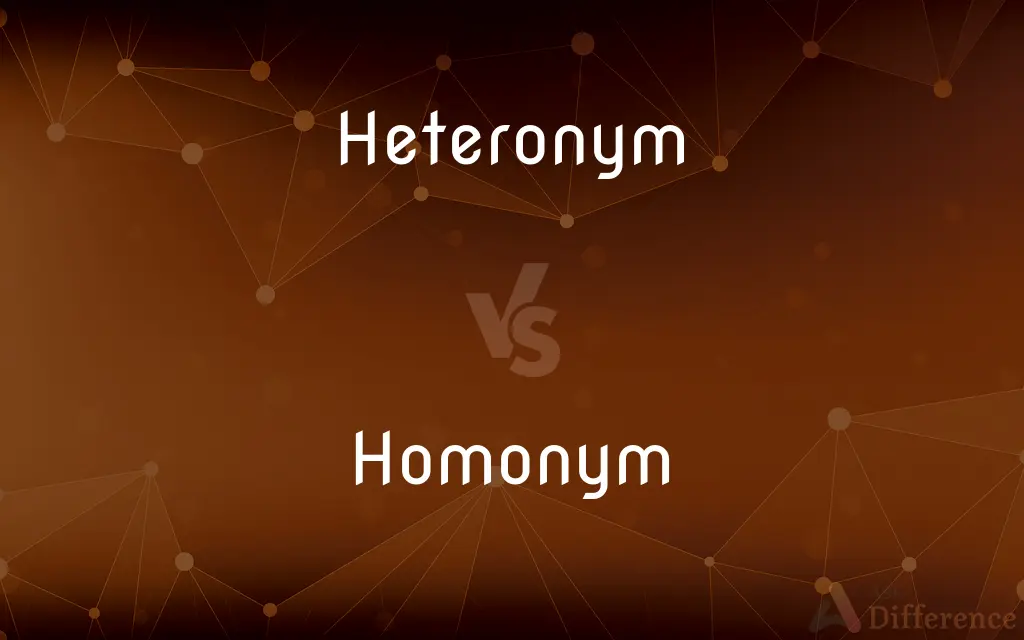Heteronym vs. Homonym — What's the Difference?
Edited by Tayyaba Rehman — By Fiza Rafique — Updated on April 2, 2024
Heteronyms are words that are spelled identically but have different meanings and often different pronunciations. Homonyms, on the other hand, share the same spelling and pronunciation but have different meanings.

Difference Between Heteronym and Homonym
Table of Contents
ADVERTISEMENT
Key Differences
Heteronyms are fascinating because they are spelled the same but differ in both pronunciation and meaning, requiring context for correct interpretation. For instance, "lead" can mean to guide someone or refer to a heavy metal, pronounced differently in each case. On the other hand, homonyms add another layer of complexity to the English language by sharing both spelling and pronunciation while differing in meaning. Words like "bat" can refer to a piece of sports equipment or a nocturnal flying mammal, with the context being crucial for understanding.
While heteronyms challenge the reader or listener to use context clues to determine both pronunciation and meaning, such as the difference between "read" (to look at and comprehend the meaning of written or printed matter) and "read" (the past tense of read), homonyms require the audience to discern meaning based solely on context since their pronunciation does not change. For example, "bark" can mean the sound a dog makes or the outer covering of a tree, with no pronunciation cues to guide interpretation.
Heteronyms often arise from the rich history of English, incorporating elements from various languages and evolving over time, which explains the pronunciation differences. "Wind" (to turn something) and "wind" (movement of air) demonstrate how one word can travel through different meanings and sounds. Conversely, homonyms typically emerge from the language's tendency to reuse or repurpose sounds and spellings for entirely different objects or concepts, such as "bank" (the side of a river) and "bank" (a financial institution).
In terms of usage, heteronyms can add a layer of sophistication or complexity to text, demanding higher comprehension skills from the reader or listener. This characteristic makes them less common in everyday language but valued in literature and poetry. Homonyms, however, are prevalent in daily speech and writing, often leading to puns and wordplay because they seamlessly fit into various contexts without changing pronunciation, like "left" (the opposite of right) and "left" (the past tense of leave).
Understanding and distinguishing between heteronyms and homonyms is crucial for effective communication and literacy in English. It requires a keen awareness of context, pronunciation, and meaning, skills that are developed over time through reading, listening, and speaking the language. The ability to navigate these nuances not only enhances comprehension but also enriches one's appreciation for the complexity and beauty of English.
ADVERTISEMENT
Comparison Chart
Spelling
Identical
Identical
Pronunciation
Often different
Same
Meaning
Different
Different
Usage
More complex contexts
Common in everyday language
Example
"Lead" (to guide) vs. "lead" (a metal)
"Bat" (flying mammal) vs. "bat" (sports equipment)
Compare with Definitions
Heteronym
(v) to rip apart or into pieces.
Be careful not to tear the paper.
Homonym
(n) a piece of sports equipment used in baseball.
He swung the bat and hit a home run.
Heteronym
(n) a drop of clear salty liquid secreted by glands in your eyes.
A tear rolled down her cheek.
Homonym
(n) the side of a river.
We sat on the river bank watching the water flow.
Heteronym
(v) to propel a boat by means of oars.
We will row across the lake.
Homonym
(n) a financial institution.
I deposited some money into my bank yesterday.
Heteronym
(n) a noisy dispute or quarrel.
There was a loud row in the pub last night.
Homonym
(n) a nocturnal flying mammal.
A bat flew out of the cave at dusk.
Heteronym
(v) to guide or direct in a course.
She will lead the team to victory.
Homonym
(v) the sound a dog makes.
My dog barks every time someone rings the doorbell.
Heteronym
(n) a heavy, bluish-gray metal, Pb.
The pipes were made of lead.
Homonym
(n) the outer covering of a tree.
The bark of this tree is very rough.
Heteronym
One of two or more words that have identical spellings but different meanings and pronunciations, such as row (a series of objects arranged in a line), pronounced (rō), and row (a fight), pronounced (rou).
Homonym
In linguistics, homonyms, broadly defined, are words which are homographs (words that share the same spelling, regardless of pronunciation) or homophones (words that share the same pronunciation, regardless of spelling), or both. For example, according to this definition, the words row (propel with oars), row (argument) and row (a linear arrangement) are homonyms, as are the words see (vision) and sea (body of water).
Heteronym
(linguistics) A word having the same spelling as another, but a different pronunciation and meaning.
Agape, "astonished" or "wide open," is a heteronym of agape, "Christian love."
Homonym
Each of two or more words having the same spelling or pronunciation but different meanings and origins.
Heteronym
(literature) A fictitious character created by an author for the purpose of writing in a different style.
Homonym
One of two or more words that have the same sound and often the same spelling but differ in meaning, such as bank (embankment) and bank (place where money is kept).
Heteronym
That which is heteronymous; a thing having a different name or designation from some other thing; - opposed to homonym.
Homonym
A word used to designate several different things.
Heteronym
Two words are heteronyms if they are spelled the same way but differ in pronunciation (e.g. `bow')
Homonym
A namesake.
Homonym
(Biology) A taxonomic name identical to one previously applied to a different species or other taxon and therefore unacceptable in its new use.
Homonym
A word that both sounds and is spelled the same as another word.
Homonym
(loosely) A word that sounds or is spelled the same as another word (but not necessarily both), technically called a homophone (same sound, different spelling) or a homograph (same spelling, different sound), or if both are the same, a homonym.
Homonym
(taxonomy) A name for a taxon that is identical in spelling to another name that belongs to a different taxon.
Homonym
A word having the same sound as another, but differing from it in meaning; as the noun bear and the verb bear.
Homonym
Two words are homonyms if they are pronounced or spelled the same way but have different meanings
Common Curiosities
What's an example of a homonym?
"Bat" can mean a flying mammal or a piece of sports equipment.
Can you give an example of a heteronym?
"Lead," when pronounced as /lēd/, means to guide, while pronounced as /led/, it refers to a metal.
What defines a homonym?
Homonyms are words that are spelled the same and pronounced the same but have different meanings.
Can a word be both a heteronym and a homonym?
By definition, no, as heteronyms and homonyms differ in pronunciation.
What are heteronyms?
Heteronyms are words that are spelled the same but have different meanings and usually different pronunciations.
How can you tell a heteronym from a homonym?
If the pronunciation changes with the meaning, it's a heteronym. If it doesn't, it's a homonym.
Are homonyms common in English?
Yes, homonyms are very common and appear frequently in everyday language.
What role do homonyms play in language?
They add richness and complexity, often leading to wordplay and puns.
Why are heteronyms challenging in English?
They require understanding of context to grasp the correct pronunciation and meaning.
Is understanding heteronyms and homonyms important?
Yes, it's crucial for effective communication and understanding nuances in English.
How do heteronyms arise?
Through the evolution of language, borrowing from different languages and changes in pronunciation.
Do heteronyms exist in other languages?
Yes, many languages have heteronyms, each with unique pronunciation and meaning nuances.
Are there any tools to help learn heteronyms and homonyms?
Dictionaries and language learning apps often provide examples and contexts.
How does context play a role in distinguishing these words?
Context clues help determine the correct pronunciation or meaning based on the situation.
How can I improve my understanding of these terms?
Through reading, listening, and practice, paying attention to context.
Share Your Discovery

Previous Comparison
Hobby vs. Sport
Next Comparison
Tweet vs. TwitAuthor Spotlight
Written by
Fiza RafiqueFiza Rafique is a skilled content writer at AskDifference.com, where she meticulously refines and enhances written pieces. Drawing from her vast editorial expertise, Fiza ensures clarity, accuracy, and precision in every article. Passionate about language, she continually seeks to elevate the quality of content for readers worldwide.
Edited by
Tayyaba RehmanTayyaba Rehman is a distinguished writer, currently serving as a primary contributor to askdifference.com. As a researcher in semantics and etymology, Tayyaba's passion for the complexity of languages and their distinctions has found a perfect home on the platform. Tayyaba delves into the intricacies of language, distinguishing between commonly confused words and phrases, thereby providing clarity for readers worldwide.














































